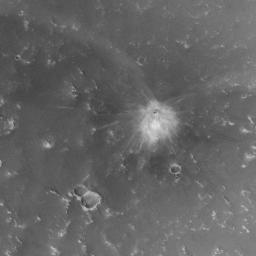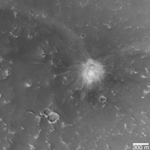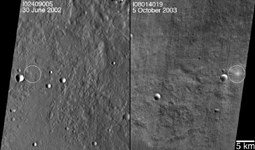Fresh Crater in Arabia Terra with Light-Toned Ejecta
Caption:
While most of the new impact craters found on Mars by the Mars Global Surveyor's Mars Orbiter Camera have dark ejecta patterns, a few of them also have light-toned ejecta, indicating that the impacting meteorite excavated to a depth where a light-toned material was present.
Figure A: The picture was acquired on Feb. 26, 2006. The single small crater of about 22.6 meters (about 74 feet) in diameter is surrounded by light and dark-toned ejecta. The crater occurs near 20.6 degrees north latitude, 356.8 degrees west longitude, in Arabia Terra.
Figure B: This set of images shows how the impact site appeared to the Mars Odyssey Thermal Emission Imaging System infrared instrument before and after the impact. The white circle indicates the location of the impact site. Both images are from the Thermal Emission Imaging System band 9 (approximately 12.6 micrometers wavelength); the first image was obtained on June 30, 2002, the second on Oct. 5, 2003. In the 2003 image, the impact site appears as a bright spot, because it was warmer than the surroundings at the time the data were acquired.
Figure C: The final figure shows how the impact site appeared to the Mars Global Surveyor Mars Orbiter wide-angle cameras. The first image shows the site before the impact, on Aug. 31, 1999. The second shows the impact site as it appeared on May 7, 2003.
Taken together, the Mars Odyssey and Mars Global Surveyor data indicate that this impact occurred some time between June 30, 2002, and May 7, 2003.
Background Info:
The Mars Global Surveyor mission is managed for NASA's Office of Space Science, Washington, by NASA's Jet Propulsion Laboratory, Pasadena, Calif., a division of the California Institute of Technology, also in Pasadena. Lockheed Martin Space Systems, Denver, developed and operates the spacecraft. Malin Space Science Systems, San Diego, Calif., built and operates the Mars Orbiter Camera.
For more information about images from the Mars Orbiter Camera, see
http://www.msss.com/mgs/moc/index.html
.
Cataloging Keywords:
| Name |
Value |
Additional Values |
| Target |
Mars |
|
| System |
|
|
| Target Type |
Planet |
|
| Mission |
Mars Global Surveyor (MGS) |
2001 Mars Odyssey |
| Instrument Host |
Mars Global Surveyor |
Mars Odyssey |
| Host Type |
Orbiter |
|
| Instrument |
Mars Orbiter Camera (MOC) |
|
| Detector |
|
|
| Extra Keywords |
Crater, Grayscale, Impact, Infrared, Thermal |
| Acquisition Date |
|
| Release Date |
2006-12-06 |
| Date in Caption |
1999-08-31 |
2002-06-30, 2003-05-07, 2003-10-05, 2006-02-26 |
| Image Credit |
NASA/JPL/Malin Space Science Systems |
| Source |
photojournal.jpl.nasa.gov/catalog/PIA09025 |
| Identifier |
PIA09025 |

 Planetary Data System
Planetary Data System



